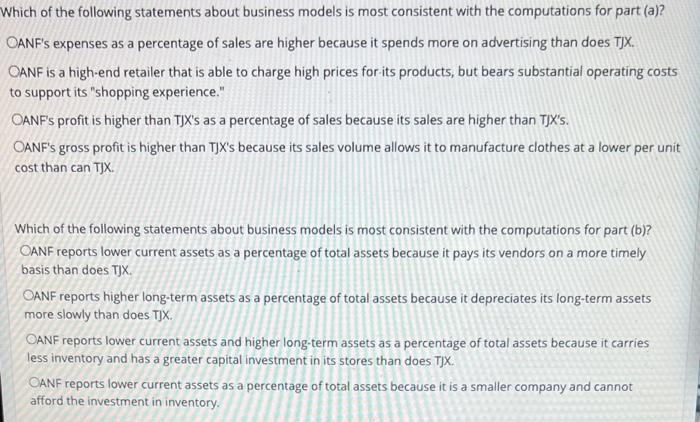Comparing Income Statements and Balance Sheets of Competitors Following are selected income statement and balance sheet data from two retailers: Abercrombie \& Fitch (clothing in the high-end market) and TJX Companies (clothing retailer in the value priced market), for the fiscal year ended February 2, 2019. (a) Express each income statement amount as a percentage of sales. Round your answers to one decimal place (ex: 0.2345=23.5%) (b) Express each balance sheet amount as a percentage of total assets. Round your answers to one decimal place (ex:0.2345=23.5%). Which of the following statements about business models is most consistent with the computations for part (a)? ANF's expenses as a percentage of sales are higher because it spends more on advertising than does TJX. ANF is a high.end retailer that is able to charge high prices for its products, but bears substantial operating costs to support its "shopping experience." ANF's profit is higher than TJX's as a percentage of sales because its sales are higher than TJX's. ANF's gross profit is higher than TJ''s because its sales volume allows it to manufacture clothes at a lower per unit cost than can TJX. Which of the following statements about business models is most consistent with the computations for part (b)? ANF reports lower current assets as a percentage of total assets because it pays its vendors on a more timely basis than does TJX, ANF reports higher long-term assets as a percentage of total assets because it depreciates its long-term assets more slowly than does TJX. ANF reports lower current assets and higher long-term assets as a percentage of total assets because it carries less inventory and has a greater capital investment in its stores than does TJX. ANF reports lower current assets as a percentage of total assets because it is a smaller company and cannot afford the investment in inventory. (c) Which company has a lower proportion of debt? What do the ratios tell us about relative riskiness of the two companies? ANF has a lower proportion of debt than does TJX, which implies that ANF is less risky than TJX. TJX has a lower proportion of debt than does ANF, which implies that TJX is less risky than ANF. ANF has a higher proportion of debt than does TJX, which implies that ANF is less risky than TJX. TJX has a higher proportion of debt than does ANF, which implies that TJX is less risky than ANF









